Arthur Conan Doyle published The Hound of the Baskervilles (1901) in the Strand Magazine as Sherlock Holmes return after The Adventures of the Final Problem (1893) (The Arthur Conan Doyle Encyclopedia ). Doyle’s story begins with Sherlock and Watson making deductions about a cane that was left in the study. The cane belongs to Holmes’s client, James Mortimer, whom brings them the case about the mysterious happenings at Baskerville hall. Mortimer presents them with an early eighteenth century manuscript about the family history of the Baskervilles. He discusses the curse and legend of the Baskervilles from Hugo Baskerville to the most recent owner Sir Charles Baskerville. According to the legend per Mortimer, Hugo Baskerville kidnapped and held against her will a young woman at the estate. The woman escaped unto the moors and Hugo pursued her where he was killed by a hellish hound. The most recent occupant, Sir Charles Baskerville, died under mysterious circumstances. The new heir, Sir Henry Baskerville, received an ominous note about taking residence in the hall upon his departure from London. Also, as Sir Henry departed from London one of his shoes went missing and is under surveillance by a mysterious stranger. Sherlock and Watson agree to look into the case. Holmes sends Watson to Devonshire and with Sir Henry Baskerville and Dr. Mortimer to investigate the case and send reports back to him. Watson arrives in Devonshire to hear about an escaped convict that is on the moors. He meets the characters, Mr. and Mrs. Barrymore whom are Sir Henry’s servants at Baskerville Hall and Jack Stapleton and his sister, Beryl, whom are neighbors. Watson catches Mr. Barrymore acting strangely around the household. Watson also hears a howling upon the moors. Watson is given a warning from Beryl Stapleton and learns about a meeting between Sir Charles and Laura Lyons on the night of his death (Spark Notes: Plot summary Hound of the Baskervilles ) (The Arthur Conan Doyle Encyclopedia ). Watson learns that the escaped convict is Mrs. Barrymore’s brother whom the couple is helping. Watson finds Sherlock upon the moor in disguise interviewing Laura Lyons. By noticing a similarity between the likeness of the portraits in Baskerville Hall to Jack Stapleton, Holmes deduces that Jack Stapleton is actually a Baskerville and next in line to inherit the estate. Stapleton used Laura Lyons in his game towards inheriting the estate. Lyons missed her appointment with Sir Charles at the bidding of Stapleton. Then, Stapleton enticed Sir Charles to the moor where he released his dog upon him. In the final act of the story, Sherlock convinces Sir Henry to travel upon the moors in order to entice Stapleton to show his cards and attempt to kill Henry. Henry comes across Stapleton’s dog and almost perishes but Holmes and Watson rescue him. Stapleton flees and dies out in the moors. They find out that Beryl Stapleton is Jack’s wife and were left tied up in their house. Sherlock explains that the shoe was taken to given the dog Sir Henry’s scent. The note given to Sir Henry was done by Beryl because of Jack Stapleton’s intentions toward marriage with Laura Lyons (The Arthur Conan Doyle Encyclopedia ) (Spark Notes: Plot summary Hound of the Baskervilles ). If you see Figure 18 below is one of Sidney Paget’s illustrations from the story (Source credit: https://www.arthur-conan-doyle.com/index.php?title=File:Illus-houn-paget-53.jpg)
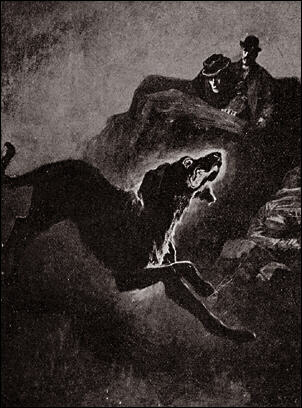
Source credit: https://www.arthur-conan-doyle.com/index.php?title=File:Illus-houn-paget-53.jpg)
The Hound of the Baskervilles story was Sir Arthur Conan Doyle’s first return of his beloved character, Sherlock Holmes after Holmes supposed death in The Adventure of the Final Problem (1893). Doyle brought gothic into the world of the Sherlock with this story. Vanacker argues that, “Although, not classified as a Gothic novel, The Hound clearly employs Gothic conventions and underpinnings. The found manuscript relating the origin of the Baskerville curse, the gloom of the enclosed primeval moor and the ominous presence of Baskerville Hall work to create what Sir Henry Baskerville refers to in the adaptation as ‘an old melodrama.’ (Vanacker 50).
The Gothic conventions and underpinnings in The Hound of the Baskervilles (1901) are: the eighteenth century manuscript laying the foundation of the Curse of the Baskervilles, the ‘wild’ waste of the Moors in Dartmoor, the supernatural hound associated with the curse, and the old Baskerville Hall itself. Clausson argues, “Watson and Holmes journey from civilized London to primitive Dartmoor, “ and the tale “…is constructed around a series of binary oppositions-science vs. imagination, reason vs. superstition, the progressive present vs. the primitive past, evolution vs. degeneration or regression…” (Clausson 65). During the course of the story, Doyle addresses each of the oppositions and Holmes emerges as the rational crime solver against the unseen Gothic forces at work within Devonshire.
There are aspects of Doyle’s The Hound of the Baskervilles (1901) which can be compared to Emily Bronte’s Wuthering Heights (1847). In Wuthering Heights the Earnshaw homestead represents the ancient past with the age written over the threshold and the moors with their wild weather represents the emotions of the characters, Heathcliff and Catherine Earnshaw at different points in the novel. Doyle’s moors are a place of death and mystery as Sir Charles Baskerville, Sir Hugo Baskerville, and Jack Stapleton perish on the moors. The Baskerville Hall represents with its gloomy standing upon the moors is representative of a gothic structure and the Baskerville history and curse. Doyle illustrates the family history with Sherlock’s observation of the family portraits and how he notices the resemblance between Stapleton and the Baskervilles.
This illustration by Paget is mirrored later in the film adaptations of the story. Some of the directorial choices made in the later cinema adaptations reflect those choices Paget made in his illustrations.
The first cinema adaptation to be examined is The Hound of the Baskervilles (1939) starring Basil Rathbone as Sherlock Holmes and Nigel Bruce as Dr. John Watson. The movie posters offering interesting choices in what they decided to convey through the colors and characters chosen. For example in Figure 19 below Sherlock is represented in silhouette by his deerstalker hat and calabash pipe, there is a frontal view of the hound with red –demon-possessed eyes to give the look of other worldly, and lastly a man and woman.
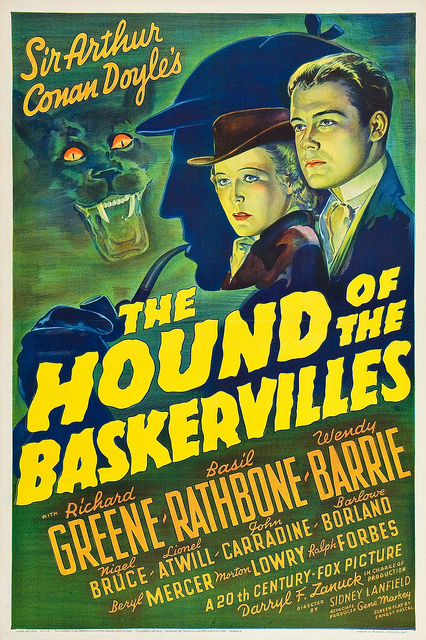
Figure 19: The Hounds of Baskervilles (1939) movie poster, Source credit: https://www.arthur-conan-doyle.com/index.php?title=File:1939_rathbone_houn_affiche.jpg
Figure 19: The Hounds of Baskervilles (1939) movie poster, Source credit: https://www.arthur-conan-doyle.com/index.php?title=File:1939_rathbone_houn_affiche.jpg
Figure 20 shows a third movie poster out of the six done for the movie. This poster has a darker color scheme matching more the gothic tones of the story. There is picture window in the bottom left hand corner which shows Sherlock bending over a body, red paw prints that walk across the poster from left to right, Holmes shown in his deerstalker hat and with the calabash pipe, and the man and woman again.
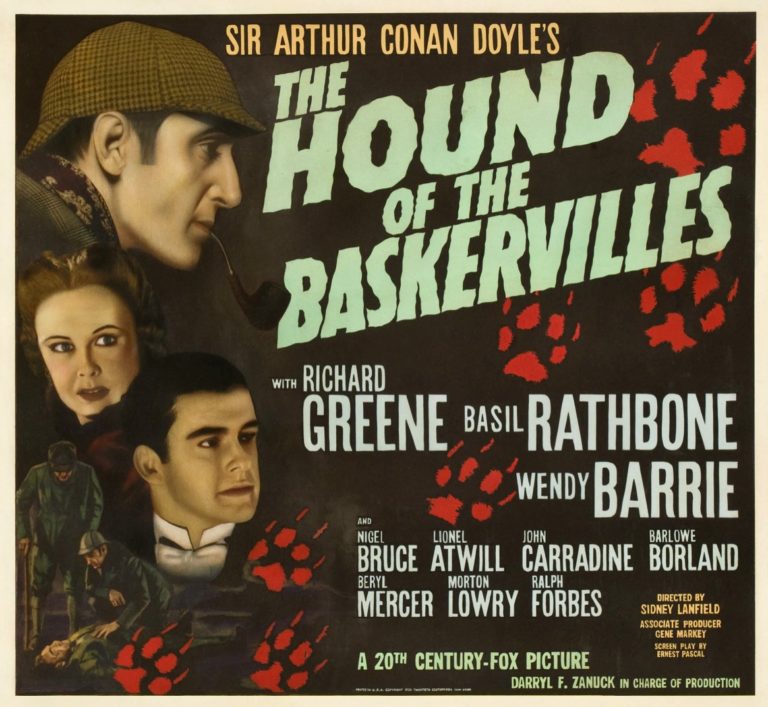
Figure 20: The Hound of the Baskervilles (1939) Source credit: https://www.arthur-conan-doyle.com/index.php?title=File:1939_rathbone_houn_affiche_square.jpg
Sidney Lanfield directed this adaptation and the screenplay was written by Ernest Pascal. The movie was Rathbone’s first portrayal of the character, Sherlock Holmes (The Arthur Conan Doyle Encyclopedia ). The Rathbone version follows Doyle’s original story closely. The movie begins with an older man on the moors. There is the sound of a howling dog in the background, a woman screams, and the older man collapses. Dr. Mortimer visits Sherlock and Watson with the manuscript and the “curse” of the Baskervilles is told in flashback. Watson goes with Dr. Mortimer and Sir Henry Baskerville up to Devonshire and Baskerville Hall while Sherlock stays behind. Watson meets the servants, Mr. and Mrs. Barrymore. Also, Ms. Stapleton thinking Watson is Henry gives him an ominous warning about the moors and the hall. Sir Henry begins to pursue Ms. Beryl Stapleton and they become engaged. Watson finds Holmes in disguise upon the moors. Sherlock shares the news with the Barrymore’s that the convict has passed away upon the moors. Sir Henry crosses the moors as bait and Jack Stapleton lets loose the hound to attack him. Sherlock and Watson come upon him just in time, killing the hound and saving Sir Henry. Stapleton dies upon the moors as Sherlock explains the crime. Dr. Mortimer comments that Sherlock is the greatest detective.
Contrasting this adaptation against the original story and signs; the changes are more subtle. Leitch describes the Universal Rathbone Holmes as, “unlike Conan Doyle’s Holmes, whose proud ignorance of the fact that the earth orbited the sun made his limitations almost as notable as his accomplishments, the Universal Holmes is a thinking machine who is also a master of disguise, a connoisseur of the arts who knows how to treat a lady even though he will never settle down with one, and a politically astute consultant who can survive repeated brushes with violent death.” (Leitch 222). Rathbone’s “thinking machine” Sherlock Holmes who deduces the crimes before the other characters and they stumble around the story. Although, in The Hound of the Baskervilles Watson is shown as the primary investigator until Holmes is revealed to be in disguise. Nigel Bruce’s Watson compared to Basil’s Sherlock comes off as incompetent and a side kick whom Holmes explains everything too. While Doyle’s Watson can hold his own with Sherlock. Moriarty does not play in this story. The sign of the cape, pipe, and hat play a role in how Universal uses them as part of Rathbone’s wardrobe and in different scenes.
The second adaptation is the second television movie in the Granada series starring Jeremy Brett and Edward Hardwicke as Sherlock and Watson. It was directed by Brian Mills and the screenplay written by Trevor Bowen. This Hound of the Baskervilles aired in 1988. (The Arthur Conan Doyle Encyclopedia ). The mysterious death of Sir Charles Baskerville opens the film with the unspoken audience question whether the death was natural causes or the Baskerville curse. The hound’s legend is known in the town and upon the moors with the story of his ancestor, Hugo Baskerville’s demise. The new heir, Sir Henry Baskerville is the recipient of an ominous letter to not take residence in his ancestral home. Watson travels with Henry and in charge of his safety while Holmes remains in London on other investigations. Mysterious happenings occur at Baskerville Hall with the servant signaling to something on the moor and Beryl Stapleton issuing a warning. Holmes reveals himself and the mystery that Jack Stapleton is actually a Baskerville trying to gain the estate (The Arthur Conan Doyle Encyclopedia ).
To contrast this adaptation against Doyle’s original story there are subtle differences between the two. Leitch argues that Jeremy Brett’s performance “ instead of making himself into Holmes, Brett recreates Holmes in his own image as a theatrical manic-depressive whose historic outbursts repeatedly sacrifice fidelity to Conan Doyle for the sake of dramatic effectiveness” (Leitch 227). The dramatic effectiveness within the Granada episodes also is a stylized version of the Victorian era. Vanacker argues that “the series took on the status of a period heritage classic, one that entertained and distracted the audience by conjuring up images of the nineteenth century….sort of clichéd pastiche of ‘over-furnished parlors, horse-drawn carriages on cobbled streets, and a lot of arch acting by persons in side-whiskers or bustles” (Vanacker 41). Watson in the adaptation seems to not understand the different moving parts until Sherlock explains them to him.
Examining this adaptation visually in how Sherlock is presented also shows differences.
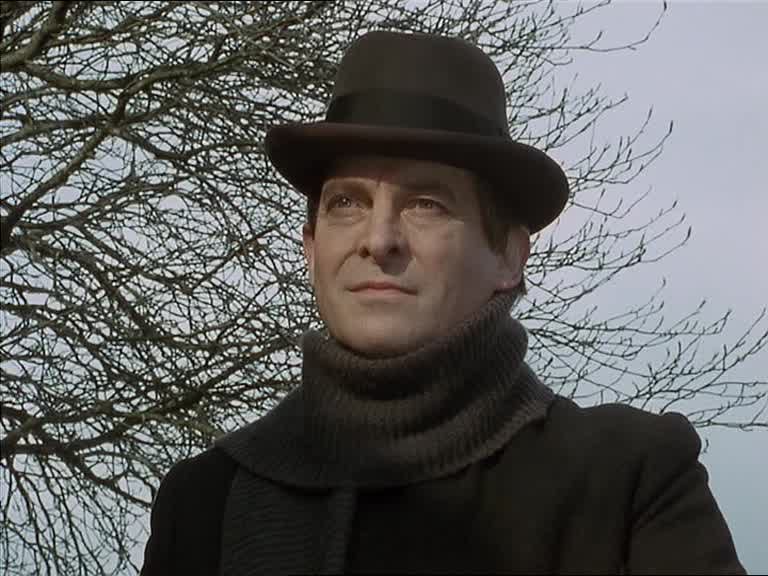
Figure 21 Source credit: https://www.arthur-conan-doyle.com/index.php?title=File:Granada-houn-1-Sherlock-Holmes.jpg
For example with Figure 21 shows Jeremy Brett in a tall derby hat with grey scarf.
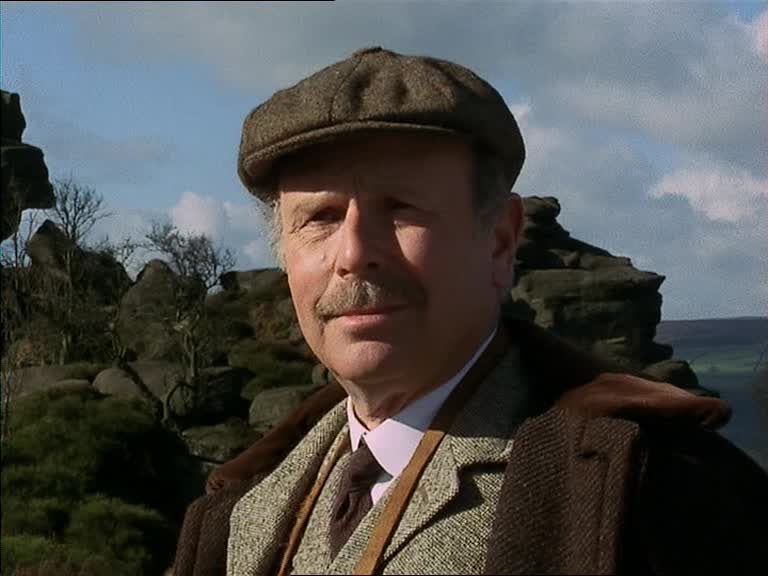
In most other adaptations Sherlock Holmes is shown with the iconic deerstalker hat, calabash pipe, and inverness cape.
Works Cited
Clausson, Nils. “Degeneration, “Fin-de-Siecle” Gothic, and the Science of Detection: Arthur Conan Doyle’s “The Hound of the Baskervilles” and the Emergence of the Modern Detective Story .” Journal of Narrative Theory, Vol. 35, No. 1 (Winter 2005) (2005): 60-87. Web.
Leitch, Thomas. Film Adaptations and Its Discontents: From Gone with the Wind to The Passion of the Christ. John Hopkins University Press , 2007. Print .
Spark Notes: Plot summary Hound of the Baskervilles . n.d. web. October 2016.
The Arthur Conan Doyle Encyclopedia . 23 August 2016. Web. 4 October 2016.
Vanacker, Sabine and Catherine Wynne (Eds.). Sherlock Holmes and Conan Doyle: Multi-media Afterlives. Palgrave MacMillan, 2013. Print .